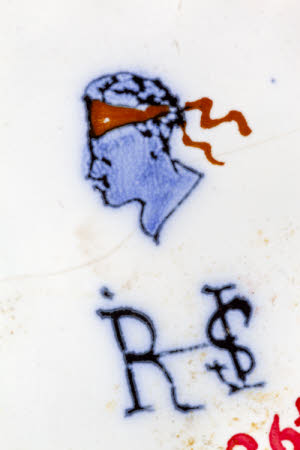Two Het Moriaenshooft factory faience teapots
Rochus Jacobsz. Hoppesteyn (1661 - 1692)
Category
Ceramics
Date
1686 - 1688
Materials
earthenware, tin-glazed (faience), inglaze pigments, red enamel, gold
Place of origin
Delft
Order this imageCollection
Wallington, Northumberland
NT 582046
Summary
Two teapots, tin-glazed earthenware (faience), painted with enamel colours, gilded, made at the factory of Rochus Jacobz. Hoppesteyn ('Het Moriaenshooft' / 'The Moor’s Head') Delft, the Netherlands, c.1686–8. Based on teapots imported from Yixing, China.
Full description
In 1688, the wealthy merchant Sir William Blackett (1657–1705), who had been made a baronet in 1685, purchased the estate at Wallington, Northumberland, to create a private retreat away from his palatial town house in Newcastle, Anderson Place. Blackett was co-heir to one of the largest fortunes in the North-East, derived from shipping, coal and lead mines, and trade between Newcastle, Stockholm and Amsterdam. In 1703, his goods were seized in Copenhagen and released only through diplomatic intervention, evidence of his powerful international connections. This rare pair of polychrome teapots, made at Het Moriaenshooft factory in Delft, then owned by the founder’s son, Rochus Jacobz. Hoppesteyn (1661–92), may have been an imported luxury acquired through Blackett’s agents in Amsterdam. Their hexagonal form, with an upright, yoke-shaped handle, copies directly a specific teapot shape made in red stoneware, near Yixing, in Jiangsu province, China. The Dutch East India Company had been importing Yixing teapots in a variety of shapes since the 1670s. The Yixing prototype for the Wallington teapots is uncommon, but variants are illustrated in an engraving of a Dutch interior by Pieter van den Berge (1702–26), ‘Namiddag / L’Après Dinée’, and a printed London broadside advertising the ‘sale of several rich Indian goods’ by lottery, dated 1694. The Het Moriaenshooft factory also produced a more common hexagonal teapot with the standard low side handle, after another Yixing model. In competition with these Asian imports, which included colourful Japanese Kakiemon-style teapots, the Het Moriaenshooft factory's proprietors invented a new type of polychrome faience, combining enamels with inglaze pigments. Around 1680, they developed a low-fired, garnet-coloured red enamel extracted from ferruginous clay. This was combined with the usual high-fired pigments: cobalt blue, manganese purple, copper green and iron yellow. This was followed by a second, low-temperature decoration - an expensive process that limited the market for such wares to wealthy merchants, gentry and aristocrats. An early example of the firm’s new palette is an armorial table services that commemorates the marriage in 1682 of Sophia Dorothea of Brunswick-Lüneburg and George Louis, Elector of Hanover, later George I of Great Britain. One of the Wallington teapots is decorated with flower-filled archaistic vases inspired by Chinese porcelain of the 1640s and the other has branches of flowering paulownia and chrysanthemums. Both were possible painted by Jeremias Godtling (c.1642–1704). The factory closed in 1692, on Hoppesteyn’s death, and their exquisite standard of workmanship was rarely repeated thereafter. Note on factory name: The 'moor's head' - the head of a black person (sometimes crowned, sometimes ‘wreathed’ about the head) - appears frequently as a motif (or charge) in medieval European heraldry. In the language of heraldry, the person depicted is described (or blazoned) as a ‘maure’, ‘moor’, ‘blackmoor’ or ‘blackamoor’, and the motif as ‘a maure’s head’ or ‘a moor’s head’, and so on. The term ‘maure’ derives from the Greek work ‘mauros’ meaning ‘black’ or ‘very dark’ and, in the medieval and early modern periods, was an ill-defined stereotype applied to Muslims of the Islamic Iberian Peninsula and North Africa. Usage developed to conflate Muslims of any ethnicity with black Sub-Saharan Africans. The image of the ‘moor’ or ‘blackamoor’ in European heraldry is itself usually stereotyped. Precisely when and where this motif was adopted as an heraldic charge is unknown, but the earliest example is thought to date from 11th century Italy. Its origins may lie in the invasion of Spain and Portugal in 711 by Africa and Arab Muslim forces. In Western Europe, the device may have referred to the black Egyptian St. Maurice, the patron saint of the Holy Roman Empire from the beginning of the 10th century, or to denote participation in the Crusades. Sometimes, in England, the device is used in what are known as ‘canting’ arms, and are incorporated into the arms of a family called ‘More’ or ‘More’, as a pun on their name.
Provenance
Given with the property to the National Trust in 1941 by Sir Charles Philips Trevelyan 3rd Bt (1870-1958).
Credit line
The Trevelyan Collection, Wallington, National Trust Collections
Makers and roles
Rochus Jacobsz. Hoppesteyn (1661 - 1692), manufacturer
References
Ferguson 2016: Patricia F. Ferguson, Ceramics: 400 Years of British Collecting in 100 Masterpieces, Philip Wilson Publishers, 2016, pp. 44-5

